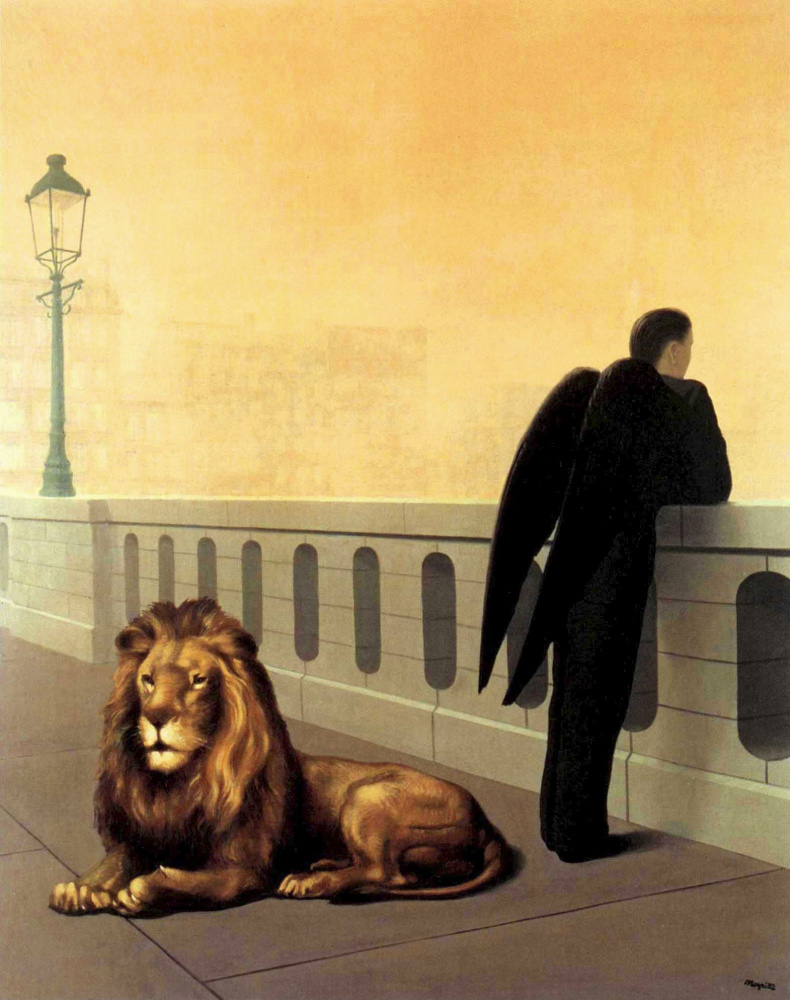log in
Enter site
Login to use Arthive functionality to the maximum
Homesickness
René Magritte • Painting, 1940, 102×81 cm
Description of the artwork «Homesickness»
"Homesickness" - undoubtedly one of the most intimate and emotionally explicit works of Rene Magritte. This can even be judged by the title: instead of choosing something traditionally whimsical and surreal, the artist names the canvas short and honest, which reflects his feelings at the time of painting.
In 1940, Belgium was captured by the Nazis during World War II, and Magritte had to flee the country. It is easy to assume that in "Homesickness" the artist directly speaks of what he experienced, being practically in exile. However, some art critics believe that there is a deeper meaning in the picture and its name. Homesickness in this case is also the inability to return to childhood, the most carefree and serene period of life. However, the childhood of Rene Magritte himself was like this only up to a certain point. The family often moved, and when the boy was only 13 years old, his mother committed suicide. It was a difficult test for a child on the threshold of adolescence. In 1928, Rene's father also passed away, and his wife Georgette remained the closest person to Magritte. At that time, the couple lived in the suburbs of Paris and were very homesick. After some time, they nevertheless returned to Brussels, and very soon his first fame came to Magritte.
In the second half of the 1930s, Rene Magritte traveled to London, where he unexpectedly fell in love with the young model and surrealist artist Sheila Legg. Not wishing to hurt his wife and arouse her unnecessary suspicions, the artist asked his friend Paul Colinet to spend more time with Georgette. This, quite expectedly, ended in a romance, and at some point Georgette even offered Magritte a divorce.
And so it happened that in 1940 the artist found himself not only far from home, but also from his beloved woman, who refused to go with him. Magritte spent three months in Carcassonne, France, in the company of the poets Paul Eluard and Louis Scutener. And then he wrote "Longing for the Homeland", in which he depicted, as art critics believe, himself in the form of a lonely angel on the bridge. One can only assume what gloomy thoughts swarmed in the head of a person, metaphorically “thrown from heaven to earth”, left without a home and without a dear soul. Some experts believe that in this picture, the lion, with its back to the angel, indifferent and indifferent, symbolizes Georgette, and the composition as a whole - the tense relationship between the spouses at that time.
Author: Evgenia Sidelnikova
In 1940, Belgium was captured by the Nazis during World War II, and Magritte had to flee the country. It is easy to assume that in "Homesickness" the artist directly speaks of what he experienced, being practically in exile. However, some art critics believe that there is a deeper meaning in the picture and its name. Homesickness in this case is also the inability to return to childhood, the most carefree and serene period of life. However, the childhood of Rene Magritte himself was like this only up to a certain point. The family often moved, and when the boy was only 13 years old, his mother committed suicide. It was a difficult test for a child on the threshold of adolescence. In 1928, Rene's father also passed away, and his wife Georgette remained the closest person to Magritte. At that time, the couple lived in the suburbs of Paris and were very homesick. After some time, they nevertheless returned to Brussels, and very soon his first fame came to Magritte.
In the second half of the 1930s, Rene Magritte traveled to London, where he unexpectedly fell in love with the young model and surrealist artist Sheila Legg. Not wishing to hurt his wife and arouse her unnecessary suspicions, the artist asked his friend Paul Colinet to spend more time with Georgette. This, quite expectedly, ended in a romance, and at some point Georgette even offered Magritte a divorce.
And so it happened that in 1940 the artist found himself not only far from home, but also from his beloved woman, who refused to go with him. Magritte spent three months in Carcassonne, France, in the company of the poets Paul Eluard and Louis Scutener. And then he wrote "Longing for the Homeland", in which he depicted, as art critics believe, himself in the form of a lonely angel on the bridge. One can only assume what gloomy thoughts swarmed in the head of a person, metaphorically “thrown from heaven to earth”, left without a home and without a dear soul. Some experts believe that in this picture, the lion, with its back to the angel, indifferent and indifferent, symbolizes Georgette, and the composition as a whole - the tense relationship between the spouses at that time.
Author: Evgenia Sidelnikova




